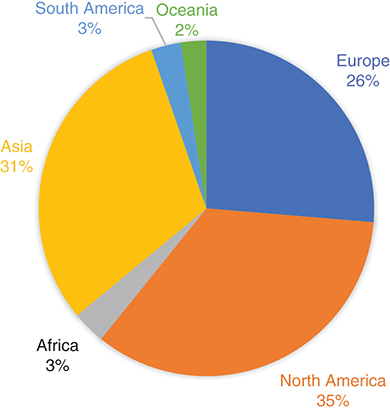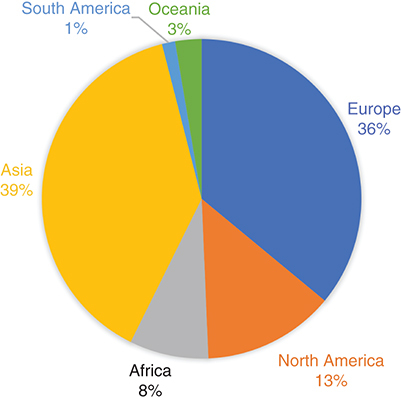Welcome to volume 8 of Future Science OA! In this short article we'd like to give you a quick roundup of the last year's publishing highlights and take a brief look ahead to 2022.
Certainly, 2020 was a unique year given the challenges to the scientific community, and indeed the world as a whole following the COVID pandemic, and 2021 saw the continuation of these challenges along with some attempt to return to a ‘new normal’ after the global vaccination roll-out and an ease of restrictions and lockdown measures. This is a perfect point to say that the completion of volume 7 of Future Science OA would certainly not have been possible without our authors and reviewers, not to mention our internal and external editorial and production teams. We are grateful for all their commitment, cooperation and hard work throughout the course of the last year.
As with all our previous volumes, content published in volume 7 of Future Science OA has continued to be of a very high standard, having gone through our rigorous peer-review and revisions process. We have published a variety of article types through the past year, such as shorter opinion-based editorials and commentaries, and longer review and perspective articles, along with original research and case reports.
Content highlights
Topics in the 2021 volume of Future Science OA have been wide ranging and fall into a variety of subject areas, from oncology, immunology, microbiology and infectious diseases, to bioinformatics, genetics and genomics; as well as, urology, gynecology and obstetrics, to name just a few.
We continued to publish interesting and valuable COVID-19-related content in 2021. COVID-19 content performing well on Altmetric included, a perspective paper titled, ‘The COVID-19 pandemic: a threat to antimicrobial resistance containment,’ published in June 2021 and written by Raspail C Founou et al. [Citation1] and ‘Cancer patients with COVID-19: a retrospective study of 51 patients in the district of Piacenza, Northern Italy,’ by Luigi Cavanna et al., and published in the January 2021 issue of the journal [Citation2].
Other content featuring as journal highlights on Altmetric include, ‘Use of amantadine in the evaluation of response to chemotherapy in lung cancer: a pilot study,’ authored by Andrew W Maksymiuk et al., published in January 2021 [Citation3], and a research article titled, ‘Antimicrobial and anti-inflammatory activities of commercial aromatizing fragrances?’, by Hagar Bach and Horacio Bach, and published In April 2021 [Citation4].
Some of our top read content for 2021 include a commentary article titled, ‘Announcing the novel class of GABA-A receptor selective positive allosteric modulator antidepressants,’ discussing this novel class of GASPAMA and their mechanism of action [Citation5]. Fasipe et al. explain that further research is necessary to ensure the classification of clinically available classes of antidepressants is regularly updated, and that more research is required to determine how, particularly in depressed patients, the interaction of GABAergic, monoaminergic and glutamatergic neurotransmission systems regulate mood and affective disorders [Citation5].
Another well received article, was written by Aravind Akella and Sudheer Akella, titled, ‘Machine learning algorithms for predicting coronary artery disease: efforts toward an open source solution [Citation6]’. In this research article, authors utilised 6 different machine learning algorithms in order to predict presence of coronary artery disease (CAD) in patients within the Cleveland dataset. In short, the results of this study demonstrated that machine learning algorithms can accurately predict for coronary artery disease and research such as this could help in the use of machine learning algorithms as a diagnostic tool for CAD [Citation6].
Further highlights include the research article, ‘Are all wines made from various grape varieties beneficial in the prevention of myocardial infarction and stroke?’, written by Iwaskai et al. [Citation7], ‘Inducible clindamycin resistance and erm genes in Staphylococcus aureus in school children in Kathmandu, Nepal,’ by Timsina et al. [Citation8], and an interesting review paper looking into the attributed functions of DHX9 in cancer development and its potential as an antineoplastic target, titled, ‘The enigmatic helicase DHX9 and its association with the hallmarks of cancer,’ by Gulliver et al. [Citation9].
Future Science Future Star Award
This year, the award gained the highest number of applicants since it was launched, along with nearly 10,000 public votes in the final round. The winner of the 2021 Future Science Future Star Award was announced in October – many congratulations to Karolina Pierzynowska, a molecular and cellular neurobiologist from the University of Gdansk (Poland) for taking the win [Citation10]! As with previous winners of the award, Karolina Pierzynowska will now be part of the Future Science OA Early Career Advisory Panel and will also be a Mentor for BioTechniques LEARN [Citation11].
Journal statistics
As reflected by the journal readership statistics below, Future Science OA has wide reach globally. The readership numbers are very similar to last year, with the majority of readers from Asia, Europe and the Americas ().
Journal authorship statistics also show a wide ranging geographic spread as seen in () below, with the majority of authors affiliated to Europe and Asia. Africa, the Americas and Oceania are represented, however, it would be good to increase contributions from these areas in the next year.
We have been able to continue to grant fee-waivers to authors from low-income countries and by publishing all our articles with a Creative Commons CC-BY license we continue to ensure accessibility of our research and content for readers across the globe.
Looking forward to 2022
This coming year, we would like to continue to build on the success of Future Science OA in providing a key resource for researchers within biotechnology, medicine and health, and a platform from which high quality research and content is published, reaching an even wider demographic as previous years. We welcome unsolicited article proposals – please do get in touch if you have any plans for submission or ideas for topic areas we should cover, we would love to hear from you! We also welcome feedback from our readers – please do get in touch!
We believe engaging with the online community via Twitter and other social media channels is very important and if you have not already done so, we would love to welcome you as a follower on Twitter (@fsgfso) [Citation12].
We would like to thank you all again for your interest in and support for Future Science OA. We look forward to an even better 2022 and to working with you all this year.
Financial & competing interests disclosure
R Wijayatunga is an employee of Future Science Ltd. The author has no other relevant affiliations or financial involvement with any organization or entity with a financial interest in or financial conflict with the subject matter or materials discussed in the manuscript apart from those disclosed.
No writing assistance was utilized in the production of this manuscript.
References
- FounouRC , BlockerAJ , NoubornMet al.The COVID-19 pandemic: a threat to antimicrobial resistance containment. Future Sci. OA7(8), FSO736 (2021).
- CavannaL , CitterioC , ToscaniIet al.Cancer patients with COVID-19: a retrospective study of 51 patients in the district of Piacenza, Northern Italy. Future Sci. OA7(1), FSO645 (2020).
- MaksymiukAW , TappiaPS , BuxRAet al.Use of amantadine in the evaluation of response to chemotherapy in lung cancer: a pilot study. Future Sci. OA7(4), FSO679 (2021).
- BachH , BachH. Antimicrobial and anti-inflammatory activities of commercial aromatizing fragrances. Future Sci. OA7(6), FSO704 (2021).
- FasipeOJ , AgedeOA , EnikuomehinAC. Announcing the novel class of GABA–A receptor selective positive allosteric modulator antidepressants. Future Sci. OA7(2), FSO654 (2020).
- AkellaA , AkellaS. Machine learning algorithms for predicting coronary artery disease: efforts toward an open source solution. Future Sci. OA7(6), FSO698 (2021).
- IwasakiM , MurakamiM , IjiriY , ShimizuM , YamamotoJ. Are all wines made from various grape varieties beneficial in the prevention of myocardial infarction and stroke?Future Sci. OA7(2), FSO649 (2020).
- TimsinaR , ShresthaU , SinghA , TimalsinaB. Inducible clindamycin resistance and erm genes in Staphylococcus aureus in school children in Kathmandu, Nepal. Future Sci. OA7(1), FSO361 (2020).
- GulliverC , HoffmannR , BaillieGS. The enigmatic helicase DHX9 and its association with the hallmarks of cancer. Future Sci. OA7(2), FSO650 (2020).
- https://www.biotechniques.com/news/future-science-future-star-award-2021-and-the-winner-is/?utm_campaign=BioTechniques&utm_content=182790687&utm_medium=social&utm_source=twitter&hss_channel=tw-21155592
- https://www.biotechniques.com/about-learn/
- https://twitter.com/fsgfso?lang=en


